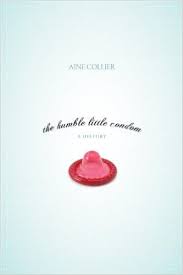 The Humble Little Condom
The Humble Little Condom
by Aine Collier
Prometheus Books. 371 pages, $18.95
SHEATH, GLOVE, PROPHYLACTIC—whatever you call them, millions of people rely on those little round wonders for birth control, disease control, and at one time libido control (or so some doctors professed). In The Humble Little Condom, author Aine Collier writes about the history of something that millions of people use but don’t discuss in polite company.
No one knows who came up with the idea of using a sheath of some sort as a means of birth control, but the ancient Greeks and Romans knew the family planning benefits of condoms. For economic reasons, the ideal family size in cities was small. If men weren’t quick to use a device to prevent children, women certainly were. Condoms came under fire in the Middle Ages through the 16th century, though they continued to be manufactured, including, Collier suggests, by Shakespeare’s father. But at this time only prostitutes and women of low reputation were said to have tolerated their use, and not just for birth control. Columbus and his men brought an explosion of disease, which climaxed during this period. Doctors decried the use of condoms, but intelligent lovers were never without them.
As European history creaked forward into the Enlightenment, condoms came into more general use. Small home factories were erected in most major cities, but nearly anyone with sheep, lamb, or calf intestines and a little lye could make their own sheaths. In Merry Olde England, condoms were sold on street corners by vendors and in shops of all types. On the other hand, pockets of resistance persisted in various countries well into modern times. In the U.S., the puritanical Comstock Act of 1873 banned the sale of condoms (among many things deemed “obscene”), making their distribution punishable by hard labor in a penitentiary and a hefty fine. Birth control in all forms was also illegal for several decades thereafter. But, of course, like all contraband for which there’s brisk demand, a black market arose and condoms continued to be made and sold furtively.
It was when Charles Goodyear came along and developed a process for harnessing rubber (the substance) that real, honest-to-Peter rubbers came into existence. Even Sears, Roebuck featured contraceptives in their catalogs. By the 1920’s, latex and cellophane gave condoms a longer wallet-life. While male prophylactics had been used for disease prevention as well as for birth control over the years, it wasn’t until the AIDS epidemic that the condom came to be used systematically to control disease. Gay men suddenly embraced their use as a matter of life and death.
The Humble Little Condom is mostly a book that you read for fun, but it also offers a serious history of a “humble” object that has nevertheless played an important cultural and demographic role. Author Aine Collier thoroughly covers everything there is to know about the history of prophylactics and social mores over the last 2,500 years or so, and she does it partly tongue-in-cheek and partly with a scholar’s eye upon the facts. The book is filled with fun-to-know asides that will tickle anyone who’s ever carried a condom in his wallet, tucked one in a glove box, fumbled for one on a nightstand, or sweated his way through a drugstore purchase when they were still kept behind the pharmacist’s counter.
____________________________________________________________________
Terri Schlichenmeyer is a syndicated columnist based in Wisconsin.





